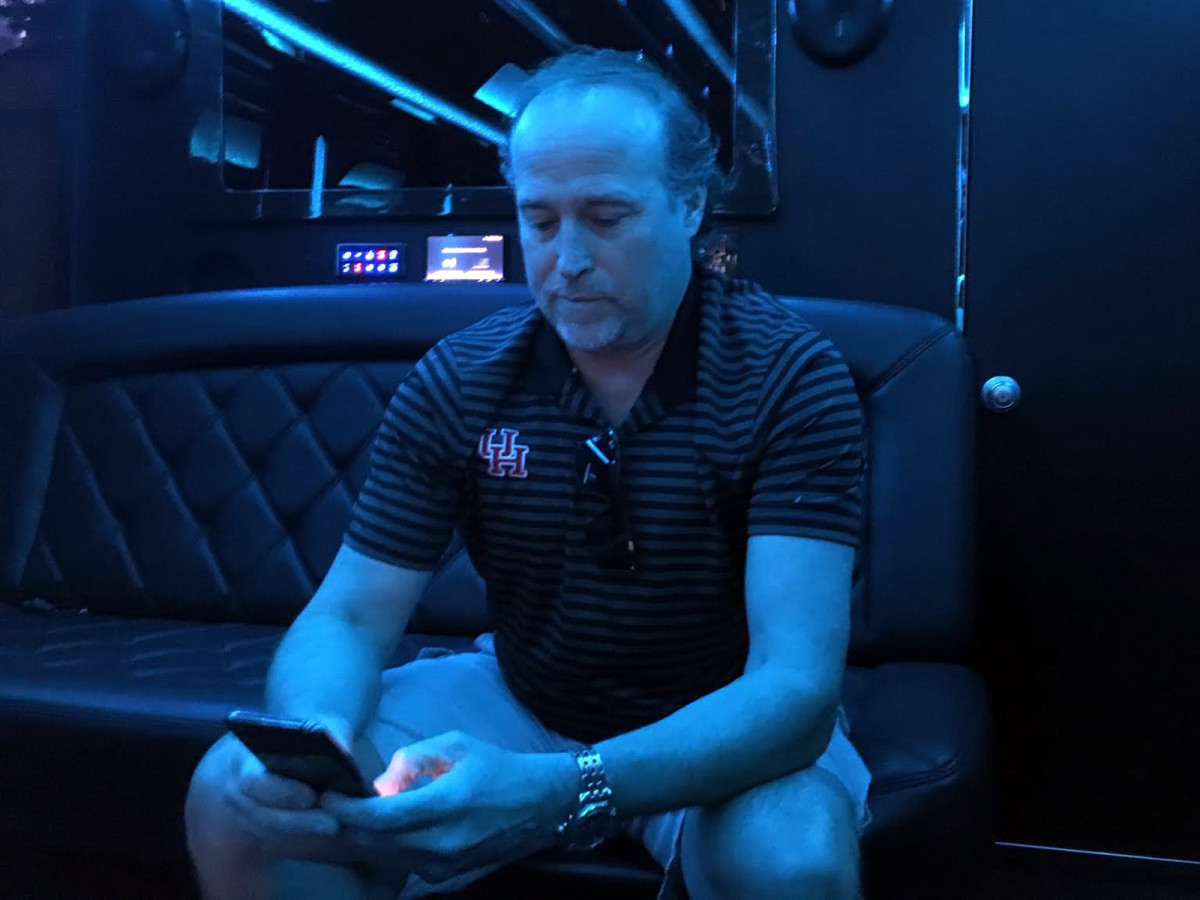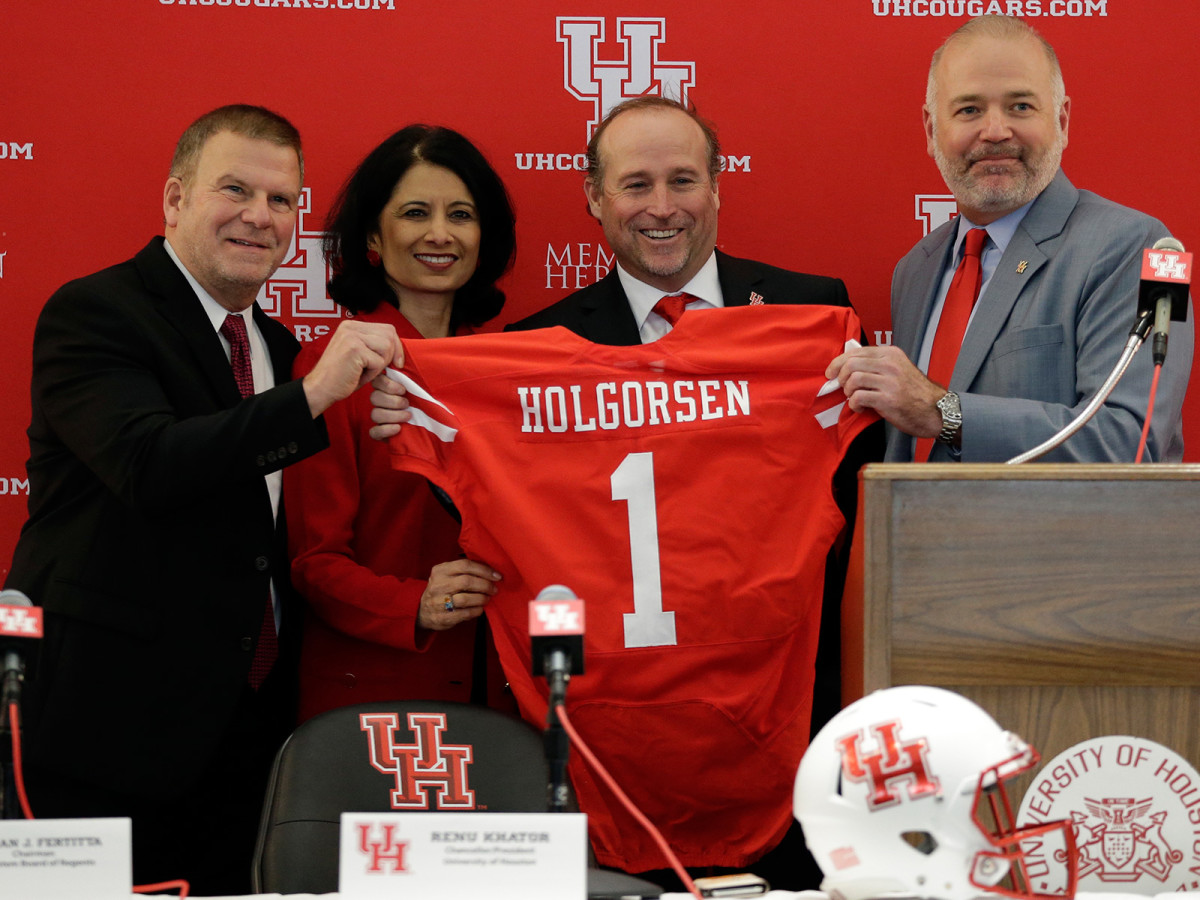Dana Holgorsen Came Back to Houston to Be Himself on His Turf

HOUSTON, Texas — We’re not going to make it. A sleek, black party bus inches through a main artery of a city so congested that it feels perpetually stuck in gridlock, and Dana Holgorsen is afraid we’re not going to make it. He’s at the very rear of the bus, alone on a cushioned bench seat for three, fiddling with his phone as the vehicle’s interior lighting rotates through the color wheel. His face is blue, then yellow, then green, then red. It is 5:09 p.m. CT, and he is scheduled to be at Minute Maid Park at 5:45 p.m. to throw the ceremonial first pitch of Astros-Yankees. That seems like plenty of time to go nine miles in any city but Houston. “This is going to be cutting it close,” Holgorsen says, loud enough for the other people aboard to detect concern in a man who’s not often outwardly concerned. “There’s a 75% chance we’re not there in time.”
His traveling party waited too late to leave its pregame dining spot, Demeris Bar-B-Q. Herding a group of 12 friends away from their drinks and food and onto a bus isn’t easy, especially when the group is the H-Town Mafia—at least that’s what the assembled revelers call themselves, a crew of wealthy, fun-loving businessmen and their wives who party-prowl around their home city. Their long-lost member, Holgorsen, has returned as the head football coach at Houston.
At Demeris Bar-B-Q’s U-shaped bar, all the talk was about his impending first pitch. Maybe Dana’s throw will be so wide that he hits a cameraman in the you-know-whats. Can he even reach the dirt around home plate, or will he roll it up there? Will this toss be more accurate than his ceremonial free throw at the Rockets game weeks ago that clanked off the side rim? Dana is sure of himself, despite his time away from baseball. He hasn’t thrown a ball since running batting practice for his son’s Little League team in 2008. “Everyone is trying to make me nervous,” Holgorsen says. “It’s not going to work.”
Twenty-minutes later, inside that party bus, Holgorsen is texting with a Houston Astros executive about how he might miss his already announced, very publicized first pitch. The coach stuffs his phone in his pocket and then spends the ride distracting himself by explaining why he left a major college job at West Virginia for a Group of Five program, how he’ll win at Houston, why he’ll call the plays and how he had to cancel a Bahamas vacation this summer with good friend and Washington State coach Mike Leach because their teams meet in Week 3 (“We can’t hang out,” Holgorsen says, smiling in a way that makes you question his truthfulness). And then, all of the sudden, through the bus’s dark tinted windows, the red break lights disappear, the on-ramps clear and the bus arrives at the foot of Minute Maid Park with nine minutes to spare. “Perfect, right?” Holgorsen jokes.
But this ride isn’t quite over yet. His group doesn’t have its tickets, and worse yet, it doesn’t know where to get them. The time is ticking. The H-Town Mafia is scurrying. And Holgorsen’s right-hand man, Ryan Dorchester, quips “Welcome to my life,” because this is all so predictable for his mad scientist of a boss.

You’re probably wondering why Holgorsen is here and not in Morgantown, after leaving a Big 12 program that he took to seven bowl games in eight years for a perennial AAC contender. He’ll tell you it is because he loves his new home city and the people in it, that his welcome with the Mountaineers was wearing off as his WVU tenure approached the decade mark and that UH isn’t like any other Group of Five program, in part because of its budget, the third-largest among G5 schools. He’ll claim that recruiting is much easier here—the city of Houston is so loaded with talent that he believes 75% of his roster should be local kids—and he expects the path to a New Year’s Six bowl to be simpler: run through the American Athletic Conference unscathed, and your case to be the Group of Five’s highest-ranked team should be pretty strong.
But maybe he did it because he’s Dana Holgorsen and Dana Holgorsen does things most people in his position might not do. Let’s face it, you could ask similar questions about his life off the field. Why does he drink four sugar-free Red Bulls on practice days and eight on game days? Why is he completely against holding a spring game? Why does he bypass a spread of sushi, carved meats and fancy desserts to instead eat fried chicken wings? Because he is unconventional in a profession full of stiff, politician-like men who venture out of their office only to take questions behind a podium or go home. “He sips culture with the people,” says Dorchester, a West Virginia graduate who followed Holgorsen to Houston.
This is a match made in humid heaven. Holgorsen is back with his people—not just the H-Town Mafia but everyone else. Holgorsen’s love affair with Houston developed during more than a decade of recruiting its metro area: as an assistant under Leach at Texas Tech (2000–07), as offensive coordinator under Kevin Sumlin at UH (08–09), as offensive coordinator under Mike Gundy at Oklahoma State (2010) and as head coach at West Virginia. Holgorsen says he used this city as a “getaway” from his high-pressure line of work and as an escape from the tiny mountain town he last called home. “The roots are deep,” he says. “I always felt like this was a place I’d like to come back to.”
He owes so much to this place. This is where, while Holgorsen’s Houston offense was breaking records with quarterback Case Keenum, the president of the city’s professional soccer team recognized his talents. Later, Oliver Luck took the West Virginia athletic director job and offered Holgorsen his first head coaching gig. Holgorsen would have returned here sooner, like in 2017 to replace Tom Herman, if he had not just signed a new contract and moved his ex-wife and children to Morgantown. “The timing wasn’t right,” says Tilman Fertitta, seated from inside his palatial work suite on the 32nd floor of his sparkling new hotel, Post Oak, in uptown Houston.
Fertitta, the 61-year-old owner of the Houston Rockets, is a central figure to this story. He’s worth $4.5 billion, is No. 153 on Forbes’s October 2018 list of the 400 wealthiest Americans and is in his sixth year as the chairman of the board of regents of the University of Houston System. If not for him, Holgorsen would almost certainly not be here, making $4 million a year, $1.1 million more than the next highest-paid Group of Five coach and the same as he would have made in Morgantown this year. Holgorsen says he never told West Virginia about the negotiations with Houston. “This was never a play for more money,” he says. Few want to speak about it extensively, but this deal was done weeks before it was announced on Jan. 2, with Fertitta and Holgorsen verbally agreeing to terms before the Cougars played in the Armed Forces Bowl on Dec. 22 while coached by Major Applewhite, an oblivious lame duck who presided over a 70–14 loss to Army. Welcome to college football.
Holgorsen hasn’t been back to West Virginia in 2019. He stayed in Florida after the Mountaineers’ loss in the Camping World Bowl for a vacation with his three children, and Fertitta picked him up there in his private jet. His parents packed up his house and sent the belongings to Houston. UH’s coup was like something out of a movie, and Fertitta envisions a happy ending. “Dana is going to be here a long time,” he says. “Dana is going to win.”

Houston’s investment in Holgorsen is a program-wide play to reach the top level of college athletics. The Cougars crave a Power 5 conference invitation—the Big 12 or Pac-12 seems most realistic—and the next opportunity for such an invite is believed to be the middle of the next decade, when the current TV deals come back up for renegotiation. A stroll across campus provides a lesson in how most Group of Five programs would like to update their résumés for conference promotion. The men’s and women’s basketball programs are based out of the Fertitta Center, which underwent $60 million in renovations last year, $20 million of which was donated by Fertitta, thus the new name. Its baseball stadium features a new $6 million clubhouse and a videoboard that is the second largest in college baseball. Its track complex got a $1.5 million upgrade in 2016, the year after Houston spent $8.6 million restoring its indoor and outdoor competition swimming pools.
And then there’s football. At the request of Holgorsen, UH increased its football-only strength staff from two members to five, the maximum allowed by the NCAA. The school added lights to its outdoor practice field. The newest and most glamorous project is a $20 million, 18-month-old indoor practice field that’d make dozens of Power 5 programs jealous. Next on the way is a football operations building in the end zone of $125 million TDECU Stadium, itself just five years old. “I know there’s this P5, G5 crap,” Houston athletic director Chris Pezman says. “We’re doing everything possible to act as if ... look, if you want to be one, you’ve got to act as one. It’s not something you can do like flipping a switch.” Everyone here seems to know that the Cougars are eventually bound for a major conference—“It’s naturally going to happen,” Holgorsen says—and UH flexed its muscles twice this spring. Three months after luring away a Power 5 head football coach, it won a bidding war with Arkansas to keep men’s basketball coach Kelvin Sampson, who led the Cougars to the Sweet 16. “The U of H is a Power 5 school not in a Power 5 conference,” Fertitta says. “Major [Applewhite] did a very good job, but we weren’t getting the excitement from the alumni and students. We wanted to bring somebody in on a different level.”
A different level? That’s Holgorsen, all right. He is different. What coach do you know who rides a party bus? “He lives like a single guy,” says Wendy Granato, by night a ranking member of the H-Town Mafia and by day the news director at Houston’s ABC affiliate, KTRK. “This just in! He is a single guy. In any other profession, it wouldn’t matter.” He’s different enough that some athletic directors would not have chanced hiring him. Pezman didn’t blink.
In a way, Holgorsen’s lifestyle is what the Cougars want in a city where the competition includes franchises from the NFL, MLB, NBA and MLS. “For us in this city, let’s be honest, we got to stand out,” Pezman says. “For him to have the freedom to be social for us and help carry that flag, if you’re married and got a bunch of young kids at home, you don’t have that opportunity as much.” Instead, Pezman has a 47-year-old divorcé who gallivants across the city spreading Houston’s brand, as he did earlier in the day at Demeris Bar-B-Q. He’s again reminding restaurant owner Yonny Demeris (a Mafia member) to rearrange the college football memorabilia on the bar’s walls. The centerpiece is a West Virginia helmet and jersey adjacent to two cans of sugar-free Red Bull. “If I come back in here and that’s not moved...” Holgorsen starts. Holgorsen’s place in the H-Town Mafia is significant. “He’s God to us,” says Marcus Payavla, another Houston restaurant owner.
Older Mafia members remember young Dana Holgorsen, when his lean muscular build and thick blond hair reminded them of a lifeguard on Baywatch. So, they began calling him just that: Baywatch. Things have changed. Time is an enemy of us all, and Holgorsen concedes that what’s left of his once flowing mane is underwhelming: “I mean, I don’t have good hair. I know.” He admits to being miffed when learning that the hairstyle of Matthew McConaughey’s character in the 2016 crime drama Gold was inspired by a photograph of Holgorsen that the actor showed to a hairdresser. Holgorsen’s revenge came last fall, when he went for and made a two-point conversion to beat McConaughey’s beloved Texas Longhorns in Austin, four hours after the coach bumped into McConaughey on the Texas sideline during warmups. “I said hello,” he laughs.
Holgorsen is not normally the nostalgic type, so don’t spend too much time asking him specifically about that call. “I don’t need memories and s---. I’m all about life experiences and living in the moment,” he says. “I don’t need you saying, ‘That’s the greatest call ever!’ I was just doing my job.”
The call was vintage Dana, a man who’s not shy to admit he’s a bit of a gambler, on and off the field. Maybe that’s rooted in the four bosses he’s worked under: brash, risk-taking mentors Hal Mumme and Leach, and motivational, program-overseeing CEOs Sumlin and Gundy. He took certain traits from each, most notably that offense of his, an adjusted Air Raid scheme that he expects to utilize his strengths: dual-threat quarterback D’Eriq King and a set of athletic receivers. Holgorsen still operates Mumme and Leach’s offense. It has no playbook, just designs and calls carried over from one year to the next that players learn through watching video and taking notes. The in-game play sheet is one of the more unique in college football: a white 8-by-10 piece of paper folded into a square small enough to stick into a breast pocket. This fall Holgorsen will call plays for the first time since 2016, when his eyesight was stronger. He will not be using Leach’s traditional call sheet. “I can’t see the plays,” he says, “and I don’t want to wear glasses.”
The three men at the bar of the Astros Diamond Club have spotted Holgorsen across the room, and they are arguing about where he coaches. One believes he’s at Texas Tech. Another says he’s still at West Virginia. A third argues that he’s Houston’s head coach. Eventually, they all agree the third man is right: Holgorsen is now at Houston. “But,” the third man tells the other two, “he doesn’t start until the fall.” Minutes later, Holgorsen chuckles when told the story. “That’s not happening in West Virginia,” he says.
As that story demonstrates, Holgorsen is a small fish in a very big pond, and that’s the way he likes it. It is part of why he moved here, to be camouflaged as a normal Houstonian surrounded by much bigger stars in town such as Alex Bregman of the Astros, James Harden of the Rockets and J.J. Watt of the Texans. Holgorsen blends in, something so unusual at his last stop that he built a man cave in his basement; in Morgantown, there was no going out anonymously. But there is more to Holgorsen’s move than what he’s coming back to. His 2018 West Virginia team, with quarterback Will Grier and a bevy of seasoned leaders felt like his best shot at winning the Big 12. The Mountaineers blew an 8–1 start and a chance to play in the conference title game by losing their final two regular season games, including a 59–56 dagger to the heart at home against Oklahoma, a defeat Holgorsen refers to as “kind of the last straw.” He could never “dethrone” the Sooners, he says, finishing 0–7 against them. He gets at least one more shot this season at a different place. The first game of his UH career will be in Norman.
Holgorsen’s plan to win here starts local. He wants his staff to recruit mostly Houston, at times venturing down the I-10 corridor to New Orleans. His motto: Recruit the best players and build relationships that can extend for years, even after some of them choose other schools. Why? Because they might, one day, come home with eligibility left. “Once they tell us they’re going somewhere else, don’t get pissed off,” Holgorsen tells his assistants.
Holgorsen dabbles in the transfer game more than most. In his final five years at West Virginia, the coach used half of his initial scholarship spots on transfers. He’s already got some transfers on board here: cornerback Marcus Jones from Troy, running back Kyle Porter from Texas and, maybe, LSU defensive lineman Dominic Livingston. But his primary recruiting territory is within a 100-mile drive—the opposite of his strategy at West Virginia, where elite high school football talent is limited. Over a 10-cycle period from 2008 to ’17, the state of West Virginia produced 28 players who signed with Power 5 schools. Over that same period, the city of Houston churned out 211 Power 5 signees. It’s why Holgorsen’s flight budget at WVU was $250,000 and why his flight budget at Houston will be close to zero. He suggests it’s also why he couldn’t topple Oklahoma. At West Virginia, he could win the Big East with local products while sprinkling in some transfers and Texas guys. Then, the Mountaineers moved conferences. “We weren’t going to get high school kids at West Virginia that we were going to win the Big 12 with,” he says.
Holgorsen explains his recruiting plan from his new Houston office. He’s redecorating, ridding the place of a motif he compares to “grandma’s home,” he says. That’s not Dana. In fact, soon enough, he’ll have two refrigerators in here in the shape of giant Red Bull cans. He might put a third in the 4,200-square foot penthouse apartment he’s leasing, on the 19th floor of a high rise between downtown and campus, with stunning views.

He’s come along way from simple beginnings, the middle child of a blue-collar family living in rural Iowa. His father and mother moved to West Virginia a few years ago to be closer to their son and grandchildren, and they’ll soon relocate to Houston. Holgorsen’s only son, Logan, is a walk-on freshman quarterback at UH, and he hired his brother Brett, a former high school football coach, as one of his new strength coaches. His two daughters have for now hung back with their mother in Morgantown, one attending WVU and another a freshman in high school. The move was hardest on his parents, Holgorsen admits. They had fallen in love with the mountains and the people of West Virginia. Moving is always a hassle, but maybe this the last one for any of them. Will he retire as Houston’s coach? Holgorsen says, “That’s the plan.”
The party bus arrives at Minute Maid Park nine minutes before Holgorsen is scheduled to throw out the first pitch. The tickets have been left at a certain gate, but no one can find the certain gate. Holgorsen leads a parade around the stadium as time ticks down—eight minutes until first pitch, seven minutes, six minutes. He politely seeks help from unhelpful security personnel and ticket takers who don’t recognize him. Finally, a police officer spots the coach in the crowd, and Holgorsen takes advantage of this opportunity. “I got to throw out the first pitch,” he says. The police officer thinks a moment. “O.K., come with me,” and just like that, we’re whisked into Minute Maid Park, riding up a slow-moving elevator and turn a corner to the Diamond Club, greeted by smiling Astros executive Reid Ryan. Holgorsen shakes Ryan’s hand at 5:45 p.m. on the dot, and the coach then turns to his party. “Right on time,” he says.
.@UHCougarFB Coach Dana Holgorsen (@Holgorsendana) throws out the ceremonial first pitch before the #Astros play the Yankees. Manager AJ Hinch was his catcher. pic.twitter.com/Lt4odniQgF
— Mark Berman (@MarkBerman_) April 8, 2019
Ryan rushes the group out to the field. The entire H-Town Mafia mills around home plate, and Holgorsen walks to the mound in his khaki shorts, tennis shoes and a newly acquired Astros jersey. He fires what he’d later call a “changeup-sinker” toward home plate, the ball crossing directly over the dish. The fans at Maid Park roar their approval, and a smiling Holgorsen jogs toward his Mafia members for a celebration. “No warmup or anything,” Dorchester notes. “Just fired it right in there. Vintage Dana.” His pitch doesn’t signal this day’s end. That happens six hours later at an open-air bar across from the park when a tune booms through the speakers and elicits plenty of chuckles. It’s John Denver. Almost heaveeen, West Virginiaaaa! A smiling Holgorsen surveys the half-empty bar and then looks to his friends. “That’s my cue to leave.”
